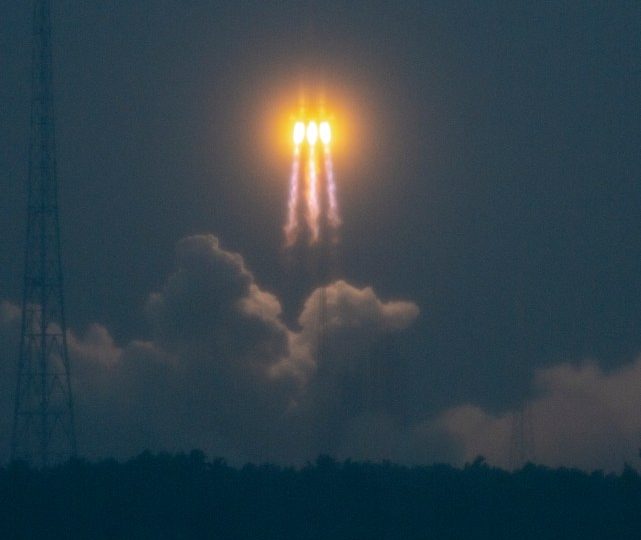CHINA has launched an uncrewed lunar mission which aims to bring back samples from the Moon’s “dark side” for the first time in history.
The launch marks a major step forward in China’s space program and in the global battle for dominance of the Moon, which experts say is reminiscent of the “Wild West”.
GettyThe Long March-5 Y8 carrier rocket carrying the Chang’e-6 lunar probe blasts off from the Wenchang Space Launch Centre on Friday[/caption]
GettyThe Chang’e-6 lunar leaves Wenchang, Hainan Province of China[/caption]
VCGChina sent its Chang’e-6 spacecraft to the ‘dark side’ of the Moon[/caption]
AFPChina’s President Xi Jinping is hoping Chang’e-6 will be the first mission to collect rock and soil samples from the far side of the Moon[/caption]
China’s Chang’e-6 robotic spacecraft is hoped by President Xi Jinping to be the first mission to collect rock and soil samples from the far side of the Moon to bring home to Earth to be studied by scientists.
But China is also said to be developing weapons which would be able to destroy, disable, or hijack satellites that the US military relies on to operate around the world.
Astrophysicist and space scientist Prof Martin Barstow said China, the US, and other global powers are desperate to lay claim to the Moon’s resources – including water on its “dark side”, which could be used to fuel rockets and to help colonise the Moon.
He told The Sun: “The Chinese are very interested in exploration of the Moon. A lot of it’s scientific, not necessarily commercial.
“Because of global power politics, the US look across at China and think, ‘Well, we can’t actually just leave them to it.’
“There are other interests, though. The US is interested in going to the Moon for long-term interests in exploring Mars, developing technologies that will help that, but doing it in an environment which is much closer to us.”
Where the Moon is three days away from Earth by rocket, Mars is about eight months away, he explained.
Executive Director of The Henry Jackson Society Dr Alan Mendoza explained that the world’s biggest powers were engaged in “a typical resource race” – the “Wild West” of space.
Nations are eager to get to the “dark side” of the Moon first to claim ownership of its resources – including water – which may help them with developments both in space and back on Earth.
Dr Mendoza told The Sun: “We’re dealing with a totally uncharted chapter here. We’ve got no real international law on the subject.
“We’ve got no concept about how things would be divided up, or how you might be able to exploit the Moon.
“Could it lead, frankly, to conflict on the Moon, with raiding bands going out there trying to seize other people’s territory? Quite possibly. It’s essentially the Wild West of space now.
“And until something gets codified, we are in a danger of having a massive resource race which could get very nasty if X or Y makes claim to the same parts of the Moon.”
Beijing has devoted “significant resources” to rapidly growing its space program over the past decade, stated the US Department of Defence’s 2023 China Military Power Report.
The Pentagon is investing billions of dollars to fend off the challenge presented by China’s space program, which it believes is directly tied to its military and to building technology for battles in orbit.
Whatever space-based nuclear weapon China may be developing “has the potential to threaten the US homeland with a new global strike capability”, a US government agency reported in November.
The US also believes Russia is developing a space-based anti-satellite nuclear weapon – an assertion flatly denied by Moscow.
In February, a source familiar with the matter claimed the detonation of Russia’s new weapon would disrupt everything from military communications to mobile phone services, Reuters reported.
The source reportedly said that the Russian system would involve a nuclear explosive device placed in orbit.
Russian President Vladimir Putin said at the time that his country was against the deployment of nuclear weapons in space.
But last week, Russia vetoed a United Nations proposal banning the use of nuclear weapons in space – as US intelligence-backed concerns Moscow wants to develop an anti-satellite nuclear device swirled.
Dr Mendoza told The Sun Russia’s veto of the resolution “obviously lends to the suspicion they might well be thinking of putting a nuclear weapon into orbit somewhere”.
He said: “And the purpose of that would be to simply try and destroy satellites.
“If you had a nuclear detonation in space, that would create an electromagnetic pulse that would knock out satellites all around.
“That’s indiscriminate, Russian satellites would be knocked out as much as anyone else, but that would have potentially devastating results.
He continued: “If you were to knock the satellites out, modern life as we know it would be severely impaired. So this is obviously a very serious threat to humanity, firstly, but secondly to any countries.
“To have the threat of this lingering over us, tells us that there’s a big problem with what the Russians, in particular, might be intending to do and what they might be looking to use this nuclear weapon as leverage for.
“And that’s why it’s so important to keep space demilitarised from these kinds of devices.”
China’s Chang’e-6 mission is expected to last about 53 days and will involve the collection of about 2kg of material using a scoop and a drill, according to Nasa.
The mission is the first of three using unmanned spacecraft that China is launching before it attempts to send people to, and build a base at, the Moon’s south pole.
China, Russia, the US, and India have all landed spacecraft on the Moon.
It is incumbent on us to get there first and to utilise our research efforts for peaceful purposes
Bill Nelson
Nasa is hoping to send the first humans to the lunar south pole in 2026, with its Artemis mission, and build a habitable base there.
The US government agency is determined to get there before China, which has previously indicated it plans to land in 2030.
Nasa chief Bill Nelson said this month: “We are in a race.
“The latest date they’ve said they’re going to land (on the Moon) is 2030 but that keeps moving up.
“It is incumbent on us to get there first and to utilise our research efforts for peaceful purposes.”
China is “very, very secretive” about its “so-called civilian space program”, he said, suggesting it was really a “military program”.
Speaking to the US budget committee, Mr Nelson said he feared China might claim parts of outer space as its own territory if it were to land on the Moon before the US.
He said: “My concern would be if China got there first and said, ‘This is our territory, you stay out.’
“Obviously you don’t want to interfere with each other but don’t declare that this whole territory is suddenly yours.”
China’s Chang’e-6 spacecraft’s mission is to collect 2kg of rock and dirt samples from the Moon’s surface
AFPA SpaceX Falcon 9 rocket lifts off from a launch pad in Florida, US in February[/caption]
The US and China are racing to lay claim to the Moon’s desirable resources
APAmerican space exploration company Intuitive Machines’ IM-1 Nova-C lunar lander is pictured in Houston in October 2023[/caption]
Leave a comment








